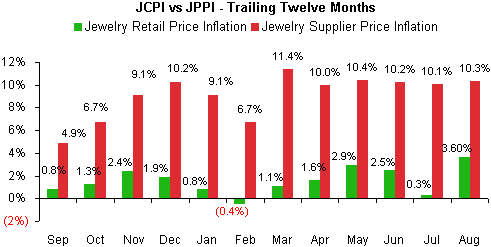IDEX Online Research: Jewelry Retail Prices Move Higher in August
October 03, 10
(IDEX Online News) - Retail jewelry prices are finally beginning to rise in the U.S. market, based on new data for August. For the past year, suppliers’ wholesale prices have been soaring, but those higher prices did not translate immediately to higher retail prices.
With an annual inventory turn of about one year, retail jewelers have been selling low-cost, older inventory for most of the past year. Now, the inventory they are selling to consumers reflects higher costs which suppliers have been charging over the past year.
IDEX Online Research has been predicting that one of two inflation scenarios would unfold: 1) retail prices of jewelry would begin to rise; or 2) suppliers would be forced to roll back prices. Based on August inflation data, there has been no slowing of price inflation at the supplier level. Rather, retail prices have finally begun to move up.
Here are the highlights of the U.S. government’s price inflation report for the month of August 2010:
· Retail jewelry and watch prices rose by 3.6 percent in August, well above last year’s average of 1.8 percent gain for the full year, and above a 1.6 percent inflation rate for 2010 year-to-date.
Retail prices of watches edged ahead by 0.5 percent in August, marking the first monthly price inflation for this category since June 2009.
· Suppliers’ jewelry prices surged by 10.3 percent this year, far above last year’s average of +3.6 percent and above 2010 year-to-date’s inflation rate of 9.8 percent.
For the past year, jewelry suppliers’ prices have been rising steadily and sharply, but jewelry prices at the retail level have shown little inflation. This has caused a margin squeeze, particularly among retailers. In August, retail jewelry prices finally began to reflect higher-cost goods from suppliers. In part, this may be due to retailers’ low inventory turns: the typical U.S. jeweler store turns its inventory about one time annually. It has taken roughly one full year for higher supplier prices to show up in jewelers’ retail prices.
The graph below summarizes both the Jewelry Consumer Price Index (green bars) versus the Jewelry Producer Price Index (red bars).

Source: BLS
What is pushing producer prices higher? Much of the pressure is coming from higher precious metals prices. Since May, gold prices have averaged over $1,200 per ounce, a trend that continues into September. Further, gold is forecasted to hit $1,300 before year-end. In prior months this year, gold averaged closer to $1,100 per ounce. Platinum has averaged between $1,500 and $1,600 per ounce for most of 2010, but has pushed above $1,600 in recent days. While this is below the levels of just over $2,000 that were experienced in 2008, today’s prices are still well above historic platinum price levels over the past decade.
The table below summarizes the JPPI and the JCPI and their major components for August 2010 as compared to the same month a year ago.
| Inflation Index | percent Change August 2010 vs. August 2009 |
| Jewelry Producer Price Index | +10.3 percent |
| -JPPI Precious Metals | +12.1 percent |
| -JPPI Watches | +1.6 percent |
| Jewelry Consumer Price Index | +3.6 percent |
| -JCPI Jewelry | +4.1 percent |
| -JCPI Watches | +0.5 percent |
Outlook
Retail and supplier prices are headed higher. As the global economy recovers, demand for precious metals for all producer and consumer sectors will increase. Further, though demand is choppy, there are already signs that consumers are returning to their former buying habits for discretionary goods, including jewelry. This means that demand will increase, and price increases will inevitably follow.
Click HERE for more detailed information about jewelry prices at the producer level and the consumer level in the U.S.
The full analysis of the jewelry prices at the producer level and the consumer level in the U.S. is available to IDEX Online Research subscribers and IDEX Online members here. Click here for more information on how to subscribe or become a member.